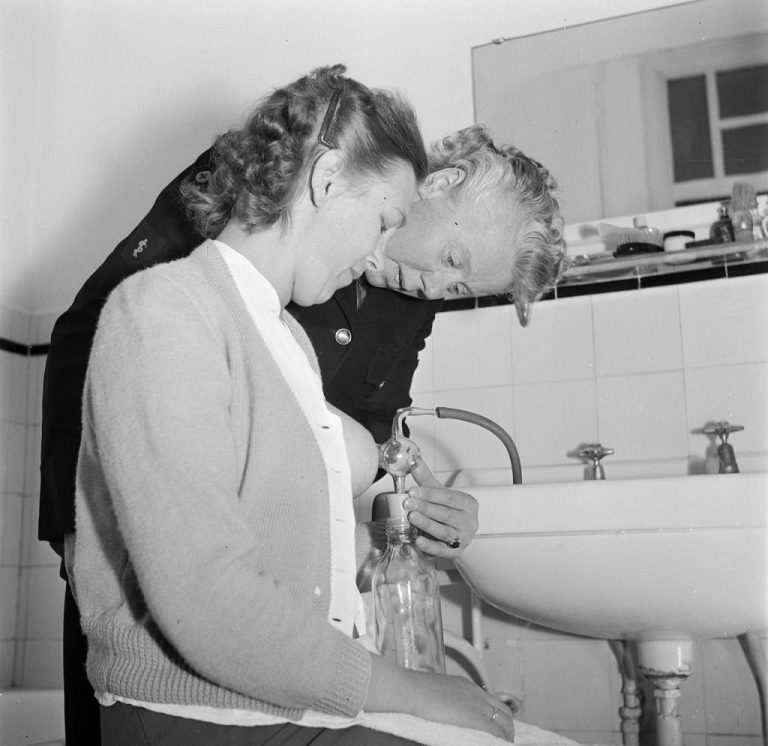Monique van der Veen observes that a cow has a better user experience thanks to the modern milking robot than a woman with a modern breast pump.
Monique van der Veen: “If you are concerned about polarisation at all, then assuming that ‘I am the problem’ is a very good option.” (Photo: Sam Rentmeester)
The first time I had to express milk I was given two bottles with shields to press against my breasts. The basic design is essentially still the same as that of the Red Cross breast pump of 1954 in the picture below, except that now it has an electric suction pump. Holding these bottles in place meant I had no hand left to actually turn on the pump. This forced me into a crouched position giving me back and shoulder pain.
 Exasperated by this, women in the past started cutting holes in bras to hold the bottles in place, a product which is now sold commercially. Yet, the dangling bottles still mean that you need to undress, and hence you are most likely find a place to be alone to express milk. Fuelled by the sentiment ‘When I first saw a breast pump I wondered if it were a joke’, MIT organised the Hackathon ‘Make the breast pump not suck’ in 2014. And don’t get me wrong, the pump should suck well, but the user experience counts too.
Exasperated by this, women in the past started cutting holes in bras to hold the bottles in place, a product which is now sold commercially. Yet, the dangling bottles still mean that you need to undress, and hence you are most likely find a place to be alone to express milk. Fuelled by the sentiment ‘When I first saw a breast pump I wondered if it were a joke’, MIT organised the Hackathon ‘Make the breast pump not suck’ in 2014. And don’t get me wrong, the pump should suck well, but the user experience counts too.
Take for example milking cows. Nowadays, this is increasingly done in an enclosure that the cow enters voluntarily which has a milking robot with lasers to guide the attachment of the teat-cups. After milking, the cow is fed a personalised diet before leaving the enclosure. The farmer is alerted by text message if there is a problem. The user experience of both cow and farmer is taken into account.
These products allow me to bypass the windowless lactation room in the new AS South Building
High on the wish list of mothers in the MIT Hackathon was a discreet, hands-free solution to be used on-the-go. So definitely not bottles dangling from breasts. Several designs with rounded collection cups that can be integrated into a bra were proposed.
Now, two breast pumps, the Elvie and the Willow, where the entire wireless pump and collection cups fit into a bra are on the market. A more economical solution is the Freemie cups: collection cups that fit into a bra which can be attached to most breast pumps on the market. If this pump is battery-powered, you can simply place it in your backpack and be mobile. These user friendly breast pumps are all by start-ups with – probably not coincidentally – female founders which managed to get a market share in a market otherwise dominated by established brands.
So as an engineering student, take this lesson to heart: whatever product you are designing, and however well you understand the associated technology, involve your end users from the start. And for me, well, these products allow me to bypass the windowless, cubicle-sized, one-person, often occupied, lactation room in the new AS South Building. A room that ended up like this because apparently it was initially forgotten about in the design. So hey, there’s a lesson here for architects too.
Monique van der Veen is Associate Professor at the Faculty of Applied Sciences, department of Chemical Engineering. You can read about the work of her research team here and follow her on Twitter at @MAvanderVeen
Monique van der Veen / Columnist


![[Column] The engineering behind milking cows and women](https://delta.tudelft.nl/wp-content/uploads/2023/12/MoniqueVanDerVeen_4622_WEB_3.jpg)
Comments are closed.